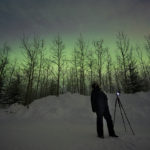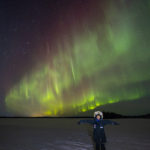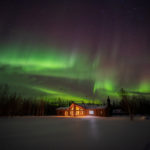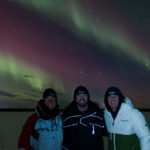The best spot to catch the aurora in Alaska? Hands down, the interior. Lots of people come here thinking just stepping foot in Alaska means they’ll see the northern lights, but honestly, that’s not always the case.
Sure, if the solar activity is really strong, you might get lucky and see them from just about anywhere, even further south near Anchorage. But most nights? The lights aren’t that wild, and the further north you are, the better your odds. I mean, they’re called the Northern Lights for a reason.
If you really want a good chance, you’ve got to be under the aurora oval, and that means heading to the interior or even further north. Fairbanks is popular, but the city itself isn’t the greatest because of all the light pollution. That’s why most of the aurora tour groups take you out of the city—way out—to spots with darker skies.
If you’re following any of those Facebook aurora groups and they mention places “south of Fairbanks,” they’re talking about darker areas away from the city where the aurora really pops off. Long story short? Skip the city lights, head to the interior, and boost your chances of seeing something incredible.

Looking for a spot to catch the northern lights without dealing with the hassle of crowded pullouts or freezing your ass off? The Face The Outdoors Aurora Viewing Lodge has got you covered. Picture this—you’re out on private property, no random people showing up to ruin the vibe, and endless dark skies all to yourself.
Forget squatting behind a tree when nature calls or shivering for hours on end. Our lodge has a warm fire, big windows to keep the show going, and (yep) a clean bathroom for those emergencies. You don’t even have to step outside if you don’t want to—just kick back, stay warm, and enjoy the auroras in TOTAL comfort.
This isn’t some sketchy roadside pullout; this is your slice of cozy paradise with the best damn view. Who’s in?
But wait, there’s more! The Face The Outdoors Aurora Viewing Lodge not only offers a comfortable and exclusive viewing experience, but also provides expert guides who are passionate about the aurora and know exactly where to look for them, that’s because Michael is born and raised here. He’ll even give you tips on how to capture the perfect photo of the lights. Plus, with complimentary snacks and hot drinks available, you can relax and fully immerse yourself in the magic of the northern lights without worrying about anything else.
And did we mention that our lodge is located in one of the best spots for catching the aurora? We’re right smack dab in the middle of the aurora oval, giving you an even better chance of witnessing this natural phenomenon in all its glory. Plus, since we’re away from the city lights, you’ll have a clearer and more unobstructed view of the lights dancing across the sky.
So why settle for a mediocre aurora viewing experience when you can have an unforgettable one with Face The Outdoors? Book your stay at our Aurora Viewing Lodge now and get ready to witness nature’s most breathtaking light show. See you under the northern lights!
And for those avid photographers out there, our lodge also offers photography workshops led by experienced professionals who know how to capture the perfect shot of the aurora. They’ll teach you about camera settings, composition, and editing techniques specifically tailored for capturing the northern lights. So not only will you get to witness the aurora, but you’ll also come away with stunning photos to show off to your friends and family.
Don’t miss out on this once-in-a-lifetime opportunity. Book now and make the most of your Alaska adventure! Keep chasing those northern lights and never stop exploring. The possibilities are endless in our beautiful state. See you soon!

When Is The Best Time To See The Northern Lights
When Is The Best Time To See The Northern Lights?
The aurora season in Alaska is between August 20th – April 20th. As early fall descends on the Interior of Alaska, the dark hours will vary as we are still losing light. Each night will get darker later and later as we head into winter.
The aurora can be more active around the fall and spring equinox’s which falls in the months of September and March, however, any night within the aurora season can be amazing! This is because the northern lights are dependent on the solar flares, and the bigger the flare or CME ( coronal mass ejection ) that leaves the sun for the earth will produce a nice display. When this flare leaves the sun it takes around 3 days before it makes contact with the earth.
If you are really wanting to up your game and put the odds even more into your favor of seeing the northern lights during your visit, then you’ll want to follow and track the space weather. The aurora is totally different than the normal Mother Nature weather we deal with, and the websites and apps that give a 27-day outlook aren’t a safe way to plan your trip. The only safest and most accurate data is the 3-day forecast.
Space Weather Live and Aurora Notify are full of information for you to plan your trip. Those that live on the West Coast can plan their trips a little more on short notice when planning around the data vs the East Coast folks, traveling eats up what could be spent on the ground under the skies.
The other factor is Mother Nature! You can see the aurora on cloudy days depending on the thickness of the clouds, and the weather is forever changing in Alaska. Opportunities do happen often giving way to the sky above. We don’t cancel our tours on the fact it’s cloudy, as more times than not the weather breaks up during the night giving way to stars and aurora.
If the aurora is really strong you will be able to see a glow through the clouds. But if it’s blown out snowing and the cloud cover is thick then you mine as well catch up on sleep! When planning your trip and you see a high KP number, you’d be doing yourself a disservice by thinking that is an indication of how the night will be and how it must be out in force. The interior of Alaska sees the aurora even on a KP0 so why is this you ask, well there are other factors involved.
All the stars need to align when being able to see the aurora. You need strong high solar winds, the higher the winds the more that space dust is moving and colliding with the atmosphere of the earth. You need to have high solar wind density to get those strong-looking bands in the sky that everyone likes so much vs the big green blobs. The Bt has got to be high so that you get those fast whipping bands across the sky as the particles snap back into the atmosphere vs bouncing off and away. The Bz you want to be negative, this puts it high in the sky vs low on the horizon and where the really fun stuff happens.
You take any one of those factors out of the equation and it affects the others, which affects what we see on the ground looking up. Just because the app you’re looking at says it’s supposed to be a Kp5 all that is, is a prediction, you need to follow the live feed of the space weather to really see what’s going on and coming.
So educate yourself some and study the information on the sites that cover it before you come. Trust me you won’t be let down as bad on a weak night when in your mind you think it’s supposed to look like the opposite. It’s a naturally occurring phenomenon so there’s not one day the same nor no switch to turn on to make it look the way you want it to.
What To Expect, And What To Bring
What Can You Expect, And What To Bring
An actual camera, not your phone camera
Headlamp
Sturdy tripod, not a cheap plastic one
SD cards, wide angle lens, extra batteries
Dress For The Conditions
So you got the trip all lined up, tours booked, and lodging! Told all your friends that you got the bucket list trip of a lifetime all planned and booked, making them all jealous of what you’re about to witness and take pictures of. Awesome! So you get up to Alaska, and see your first sighting and whip out your phone to take a picture and nothing shows up! Your picture is all black or pixelated and blurry and you don’t know why?!
Well, you might be surprised how often this happens. Everyone is so used to taking pictures with their phones these days that they don’t think that there’s a difference between day and night photography. Granted some of the newer phones can do an ok job as far as phone cameras go, but you gotta remember a phone is a phone FIRST and a camera SECOND, or THIRD!
All those beautiful pictures you saw of the northern lights prior to booking or the ones you saw that made you make up your mind about going were taken with no phone camera. I know not everyone can afford a fancy camera and there are some cheaper options with a fixed lens and interchangeable ones that can do ok and better than a phone. You can also rent a camera and lens. After all, if this is your “bucket list” trip then why not invest in it, and educate yourself on the use of a camera in manual mode. If you come up with the idea that you’re gonna get your next Instagram post shot selfie with your phone, you might be disappointed!
You’ll need a camera that can handle high ISO values and a lens that has an F-stop of 2.8 or bigger ( F2, F1.8, F1.4, F1.2 ). A wide angle lens is also key to capturing as much as the sky as your lens will allow, I use a 15mm f2 Laowa lens and at times my 24mm f1.4 on my Canon EOS R, and my Canon EOS R5. I’m not saying go break the bank on a camera, but why not look at your options of capturing this moment in your life. Here’s a reasonable option starter camera that would work, canon T7. Lensrental is a reasonably priced outfit for cameras and lenses.
Bringing a headlamp is a valuable asset as you are working out in the dark. You could actually use your phone for good use and use the flashlight on the back to see what you’re doing in the dark, but your hand is tied up. Handsfree with a headlamp.
It’s Alaska you are visiting, in the wintertime to see the northern lights so make sure to dress for it. If nothing else layer up for those that live in warmer places that won’t need the bulky cold weather gear. It’s gonna be cold and windy and the wind chill factors can be harmful to exposed skin.
A cheap plastic tripod has a higher chance of breaking in the Alaskan conditions than if you had spent a few extra bucks on a metal one. Remember what it is you are trying to accomplish here! Extra SD cards and batteries for your camera as you can easily drain a battery on a good night of lights. The more you press that shutter working that battery in the cold temps the faster it dies.
Now you’re standing under the northern lights and say to yourself why does it look that way, or is it going to get brighter, where are the colors? Remember this is a phenomenon taking place above you, and if you studied the data for the night you’d see why and understand why it’s faint. It’s not going to be bright every time you see it, it comes and goes throughout the night playing peekaboo. It does what it wants and it doesn’t wait for you to be ready. You gotta move when she’s out and about and not lollygagging getting dressed and out the door!
Set Yourself Up For Success
Set Yourself Up For Success, Not Failure!
So you got your camera, lens, tripod, and cold weather gear now what? Well, there are a few more key components you can add to your arsenal in hunting the northern lights, and that is BIG open skies! Bigger the skies the better! When you hit the jackpot on a big CME night, you’ll be amazed at how much you can see and witness.
We happen to offer such an experience. At Face The Outdoors Aurora Viewing lodge you can wait in comfort with a crackling fire until the light show begins. We have all the amenities of home at your disposal as well as big windows to keep an eye on the night sky. It beats sitting in a van all night or standing outside the van all night without a bathroom on mobile aurora tours. If you were gonna book a mobile tour and they were going to bring you down to this area, wouldn’t you rather relax in comfort with a bathroom?
Either way, you can’t go wrong with visiting Alaska no matter what time of the year. Just remember if this really is your bucket list trip, invest a little into it. Invest in the memories and moments captured that you’ll be dying to share with others and display on your walls. No one will want to show off their out-of-focus and pixelated photos as much as a piece of art that they themselves captured! We offer help with your camera settings to make sure you get those pictures worthy of bragging rights!
















Pingback:Come Experience the Best Place to See the Northern Lights in Alaska—with Kids! – Face The Outdoors